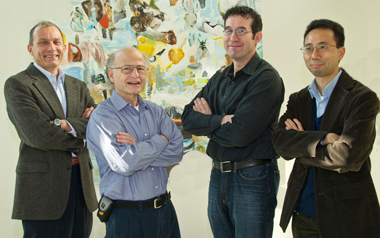UAlbany RNA Institute Researchers Partner to Pursue Biomedical Technologies
 |
|
The four University at Albany RNA scientists working with other Capital Region researchers to advance new biomedical technologies to combat disease are, left to right, Igor Lednev, The RNA Institute Director Paul Agris, Daniele Fabris and Pan T.X. Li.
|
ALBANY, N.Y. (January 15, 2013) – University at Albany RNA scientists are collaborating with leading researchers from the Wadsworth Center of the New York State Department of Health and Rensselaer Polytechnic Institute (RPI) to advance innovative biomedical technologies through The RNA Institute’s Interdisciplinary Pilot Research Program (IPRP).
The goal of these interdisciplinary collaborations is to advance research into RNA technologies that show promise in treating diseases, including cancers, neurological conditions, and drug-resistant bacterial and viral infections, through innovative medicines, vaccines and diagnostics.
The goal is to identify early-stage, interdisciplinary research that holds potential to generate external research funding or commercial applications. Each project involves collaborating researchers who are using complementary approaches at their partner institutions. Biomedical students from UAlbany are participating in the investigations.
IPRP collaborations include:
Daniele Fabris, UAlbany Departments of Chemistry and Biological Sciences, with Joan Curcio, the Wadsworth Center
RNA is a collection of molecules central to biology. One particularly interesting RNA is Ty1RNA, which is among an abundant set of RNAs common to all higher organisms. Ty1RNA appears to be important in biological evolution, and may be involved in cancer and aging. The Ty1RNA shares some important properties with viruses such as the human immunodeficiency virus (HIV). Fabris and Curcio are combining their distinctive approaches to better understand the relationship of the Ty1RNA structure to its function, in the cell and in the laboratory.
Paul F. Agris, UAlbany Departments of Biological Sciences and Chemistry, with Kathleen McDonough, the Wadsworth Center
Multi-drug-resistant gram-positive infections are an enormous problem in treating exposure. In collaboration with McDonough, Agris is uncovering a new class of small molecules that would result in an effective antibiotic that is not susceptible to creating drug-resistant infections. The biochemical space of the target of intervention will be described in detail, and biological assays will be optimized to both screen small molecule inhibitors and identify the functional implications.
Igor Lednev, UAlbany Department of Chemistry, with Angel Garcia, professor of physics, RPI
Technology development is one of the missions of UAlbany’s RNA Institute. Technologies for the study of DNA and proteins must be created for RNA study in order to advance RNA as a novel therapeutic target. In collaboration with Agris, Lednev demonstrated the potential of ultraviolet resonance Raman spectroscopy for characterization of RNA structure and its functional interaction with proteins using a model system. Lednev will demonstrate this technology in biologically relevant RNAs and RNAs with modifications and labels. In collaboration with Angel Garcia, Lednev will develop computational methods to model the structure and dynamics of biological systems.
Pan T.X. Li, UAlbany Department of Biological Sciences, with Dan Fabris, UAlbany departments of Chemistry and Biological Sciences, and Angel Garcia, professor of physics, RPI
Knowledge of RNA structures is critical for gaining insights into RNA cellular functions and for possible therapeutic applications of RNA. Li, in collaboration with Fabris and Garcia, will use state-of-the-art single molecule spectroscopy, mass spectroscopy, and molecular dynamics to elucidate RNA folding and interactions to address one of the bottlenecks of RNA biology — predicting the normal and abnormal functioning 3D structures of RNA molecules.
* * * * * *
Launched in June 2010, The RNA Institute brings together more than 50 investigators representing some 350 scientists from collaborating institutions including UAlbany's College of Arts and Sciences, College of Nanoscale Science and Engineering, and School of Public Health, as well as regional institutions, including the New York State Department of Health Wadsworth Center, Rensselaer Polytechnic Institute, and Albany Medical College, and others nationally.
The RNA Institute offers advanced facilities, including a Mass Spectrometry Center and high-end computational equipment, to support the many research projects underway. The Institute has attracted more than $14 million in research support from the state and federal governments, and private corporations. Construction of the national research resource state-of-the-art facility for RNA biomedical technology development and commercialization will be completed in the spring of 2013.
Learn more about The RNA Institute scientific team and the implications of its cutting-edge research for development and delivery of innovative medicines, vaccines and diagnostics.
comments powered by Disqus
![]() For more news, subscribe to UAlbany's RSS headline feeds
For more news, subscribe to UAlbany's RSS headline feeds
Educationally and culturally, the University at Albany-SUNY puts "The World Within Reach" for its more than 17,300 students. An internationally recognized research university with 118 undergraduate majors and minors and 138 graduate programs, UAlbany is a leader among all New York State colleges and universities in such diverse fields as criminal justice, information science, public administration, social welfare, business and sociology. With a curriculum enhanced by 500 study-abroad opportunities, UAlbany launches great careers. Visit UAlbany's extensive roster of faculty experts, and for a database of images, visit UAlbanyPhotos.


